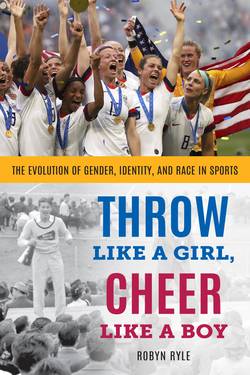Читать книгу Throw Like a Girl, Cheer Like a Boy - Robyn Ryle - Страница 11
На сайте Литреса книга снята с продажи.
Boys Over Here and Girls Over There
ОглавлениеThe history of cheerleading may be unique in the world of sports in terms of the speed in which an activity achieved a complete and total reversal of gender expectations. It’s hard to find another sport that has gone from being considered as manly as the football quarterback to about as girly as it gets in just a few decades. Ironically, today’s cheerleading resembles the original version of the activity, even if it’s mostly women who are involved. In some places, cheerleading has become a very competitive and athletically demanding sport. It is also one of the few sporting activities in which women and men compete together on a team.
We live in a world where most sports are gender-segregated, the number of sports that aren’t can be counted on one hand. Sports where women and men do compete together include NASCAR racing, thoroughbred horse racing, equestrian events, and mixed doubles tennis. Across the rest of the sports world, organizations patrol a hard line between women and men. This line can be especially harmful to transgender and intersex athletes, topics which we’ll explore more in chapters 2 and 4.
Even with the increasing numbers of openly transgender athletes, the gender segregation of sports remains a largely taken-for-granted fact of life. Before the women’s movement in places like the United States, many men and women moved through a world that was highly gender-segregated across social spheres, so the gender separation we see in sports today didn’t seem strange. But if you take a moment to think about how deeply gender-integrated most areas of our lives are today, you might wonder, what’s so special about sports? Women and men go to school together and work together across almost all professions. They work out together in gyms and belong to many of the same clubs and organizations. There are very few areas of social life that remain gender-segregated. So why do we still insist that we can’t step onto the field or the court together in a way not organized by gender?
There are some specific situations in which women and men play sports together. Many colleges and universities have co-ed intramural leagues. In some community leagues, women and men may play together. What these situations have in common is that the main purpose of playing is recreational. That isn’t to say that some intramural games on college campuses don’t get competitive, but in theory, people are playing just for the fun of it. When nothing serious is at stake, it’s okay for girls and boys or women and men to play together.
Even in these gender-integrated situations, rules are put in place to make sure that gender-integrated sports remain “fair,” and those rules are based on incorrect assumptions about gender. For example, in a co-ed basketball league, rules will probably require that at least two women be on the court at all times. The underlying assumption is that a team with four men and one woman would have an unfair advantage, because the men would be better athletes. We’ll talk about prevailing assumptions regarding gender and athletic performance in chapter 3, but for now, it’s fairly easy to see that although some men may be better basketball players than some women, there are also quite a few women who are better basketball players than some men. For example, a top player from the Women’s National Basketball Association (WNBA) would easily be able to beat an average amateur male basketball player. If you had two WNBA players on your team, you’d probably have an unfair advantage over most teams made up of five amateur men. These specific rules about what gender-integrated sports look like make sense only if you assume that every single man is a better athlete than every single woman, and that’s simply not the case.
